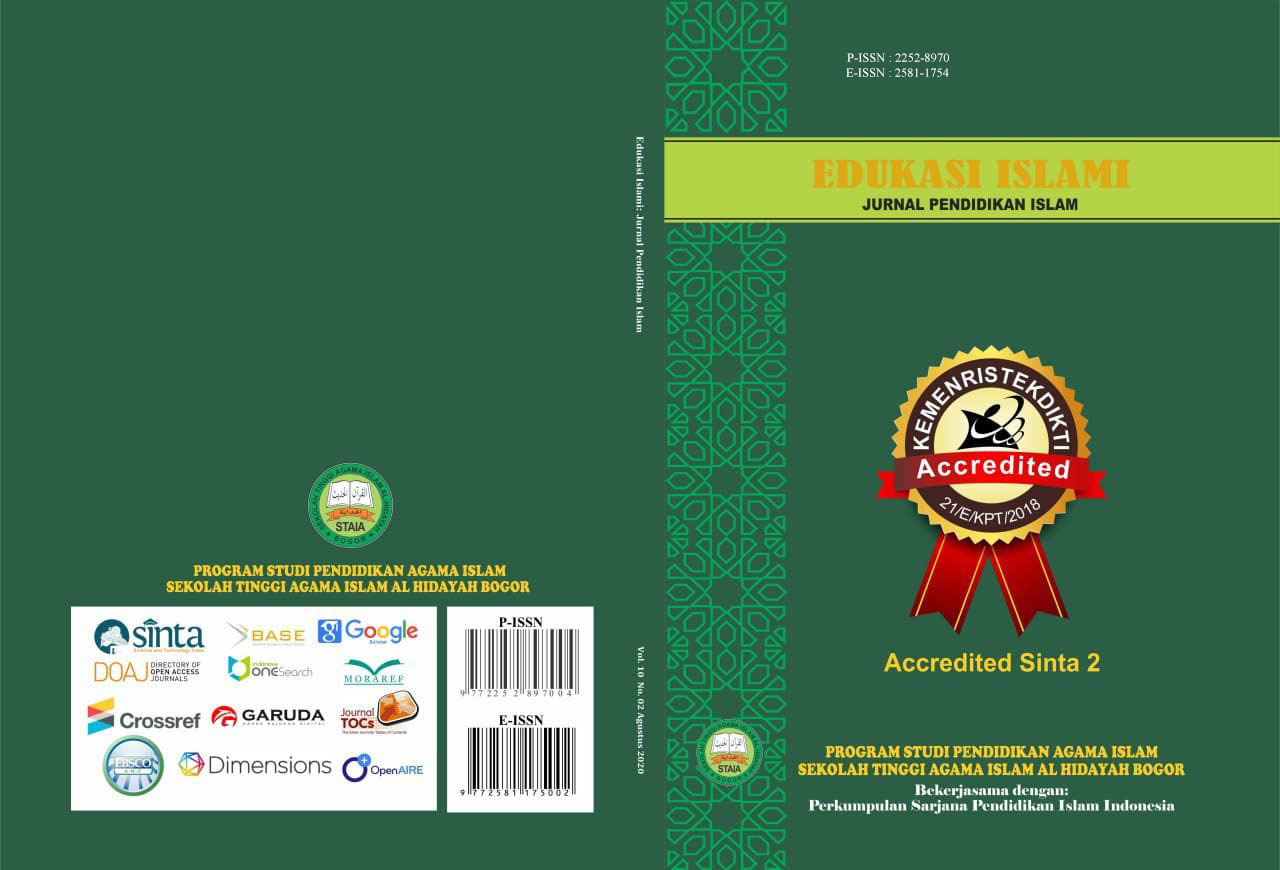Educational Evaluation: A Simple Additive Weighting Approach For Decision-Making In Transformational Leadership Development Systems
Keywords:
Education Evaluation, Simple Additive Weighting, Transformational LeaderAbstract
References
Achmad, Y. F., Laday, R. K., & Kusuma, D. A. P. (2021). Penerapan Metode Simple Additive Weighting (SAW) Pada Penilaian Kinerja Karyawan Di Pt Cirill Indonesia. Sebatik, 25(1). https://doi.org/10.46984/sebatik.v25i1.1169
Asbari, M., Fayzhall, M., Goestjahjanti, F. S., Winanti, Yuwono, T., Hutagalung, D., Basuki, S., Maesaroh, S., Mustofa, Chidir, G., Yani, A., & Purwanto, A. (2020). Peran Kepemimpinan Transformasional Dan Organisasi Pembelajaran Terhadap Kapasitas Inovasi Sekolah. EduPsyCouns: Journal of Education, Psychology and Counseling, 2(1).
Asminah, A. (2022). Penerapan Metode Simple Additive Weigthing Untuk Penentuan Level Kondisi Penyandang Disabilitas. Building of Informatics, Technology and Science (BITS), 3(4). https://doi.org/10.47065/bits.v3i4.1391
Basirun, B., & Turimah, T. (2022). Konsep Kepemimpinan Transformasional. Mindset: Jurnal Manajemen Pendidikan Islam. https://doi.org/10.58561/mindset.v1i1.28
Darsin, D., & Triyana, D. (2021). Sistem Penilaian Kinerja Karyawan Dengan Menggunakan Metode Simple Additive Weighting (SAW). Jurnal Informasi Dan Komputer, 9(1). https://doi.org/10.35959/jik.v9i1.197
Devi, M. Y., Hidayanthi, R., & Fitria, Y. (2022). Model-Model Evaluasi Pendidikan dan Model Sepuluh Langkah dalam Penilaian. Jurnal Basicedu, 6(1). https://doi.org/10.31004/basicedu.v6i1.1934
Fikri Yusmansyah, E., Sugandi, N., Miftahussalam, M., Saefurridjal, A., & Muchtarom, M. (2022). Konsep Dasar-Dasar Pertimbangan Dan Strategi Pengambilan Keputusan Dalam Kepemimpinan Pendidikan. Jurnal Pendidikan, Humaniora, Linguistik Dan Sosial (JAGADDHITA), 1(1). https://doi.org/10.58268/jagaddhita.v1i1.23
Ghufron, G. (2020). Teori-Teori Kepemimpinan. Fenomena, 19(1). https://doi.org/10.35719/fenomena.v19i1.34
Hermanto, H., & Izzah, N. (2018). Sistem Pendukung Keputusan Pemilihan Motor Dengan Metode Simple Additive Weighting (SAW). Matematika Dan Pembelajaran, 6(2). https://doi.org/10.33477/mp.v6i2.669
House, R. J., & Aditya, R. N. (1997). The social scientific study of leadership: Quo vadis? Journal of Management, 23(3). https://doi.org/10.1177/014920639702300306
Jamilus, J., & Muntatsiroh, A. (2023). Pentingnya Evaluasi Pendidikan Islam dalam Sebuah Lembaga Pendidikan. Jurnal Pendidikan Dan Konseling, 5(1).
Latifah, Z. (2021). Pentingnya Kepemimpinan Dalam Organisasi. Seminar Nasional, Vol 1, No.
Lestari, S., & Kusumah, Y. (2022). Penerapan Metode Simple Additive Weighting (SAW) Dalam Sistem Pendukung Keputusan Pemilihan Calon Peserta Pelatihan Kepemimpinan Pengawas Bagi Pejabat Struktural. Journal of Computer System and Informatics (JoSYC), 3(4). https://doi.org/10.47065/josyc.v3i4.2161
Maharta, A. N. F., & Sumardi, D. (2021). Kepemimpinan Transformasional Suatu Alternatif Pembelajaran Model Kepemimpinan Di Era Society 5.0 Bagi Taruna Akademi Angkatan Udara. Prosiding Seminar Nasional Sains Teknologi Dan Inovasi Indonesia (SENASTINDO), 3. https://doi.org/10.54706/senastindo.v3.2021.132
Mardiah, M., & Syarifudin, S. (2019). Model-model evaluasi pendidikan. Mitra Ash-shibyan: Jurnal Pendidikan Dan Konseling, 2(1). https://doi.org/10.46963/mash.v2i1.24
Mattayang, B. (2019). Tipe Dan Gaya Kepemimpinan: Suatu Tinjauan Teoritis. JEMMA | Journal of Economic, Management and Accounting, 2(2). https://doi.org/10.35914/jemma.v2i2.247
Miswanti, M. (2016). Pengintegrasian Model Leadership Menuju Model yang Lebih Komprhensip dan Parsimoni. Telaah Bisnis, 15(1). https://doi.org/10.35917/tb.v15i1.11
Miswanto. (2008). Pengembangan Model Kepemimpinan Transformasional. Jurnal Fokus Ekonomi, 7(3).
Mustakim, B. (2020). Perspektif Psikologi Pengambilan Keputusan dalam Kepemimpinan Pendidikan. Irsyad : Jurnal Bimbingan, Penyuluhan, Konseling, Dan Psikoterapi Islam, 8(2). https://doi.org/10.15575/irsyad.v8i2.1965
Rahayu, S., & Sindar, A. (2022). Sistem Pendukung Keputusan Penilaian Kinerja Guru Menggunakan Metode Simple Additive Weighting. Jurnal Ilmu Komputer Dan Informatika, 2(2). https://doi.org/10.54082/jiki.28
Setiadi, A., Yunita, Y., & Ningsih, A. R. (2018). Penerapan Metode Simple Additive Weighting(SAW) Untuk Pemilihan Siswa Terbaik. Jurnal Sisfokom (Sistem Informasi Dan Komputer), 7(2). https://doi.org/10.32736/sisfokom.v7i2.572
Sintani, L., Fachrurazi, Mulyadi, Nurcholifah, I., Fauziah, Hartono, S., & Jusman, I. A. (2022). Dasar Kepemimpinan. Cendikia Mulia Mandiri Foundation, February.
Sofiah Sinaga, N., Aprilinda, D., & Putra Budiman, A. (2021). Konsep Kepemimpinan Transformasional. Cerdika: Jurnal Ilmiah Indonesia, 1(7). https://doi.org/10.36418/cerdika.v1i7.123
Sugiyono. (2021). Metode penelitian pendidikan : kuantitatif, kualitatif, kombinasi, R&D dan penelitian tindakan. In Alfabeta,cv.
Waskito, R. R., Setya, B., & Daryanto. (2018). Sistem Pendukung Keputusan Menggunakan Metode Simple Additive Weighting Pada Ptpn Xii Perkebunan Malangsari. Jurnal Manajemen Sistem Informasi, 10(1).
Widyacahyani, A., Herawati, J., & Subiyanto, E. D. (2020). Dampak Kepemimpinan Transformasional, Kepemimpinan Transaksional dan Servant Leadership terhadap Kinerja Karyawan. Jurnal Sains Manajemen Dan Bisnis Indonesia, 10(1).
Downloads
Published
Issue
Section
Citation Check
License

This work is licensed under a Creative Commons Attribution 4.0 International License.
Authors who publish with this journal agree to the following terms:
- Authors retain copyright and grant the journal right of first publication with the work simultaneously licensed under a Creative Commons Attribution License that allows others to share the work with an acknowledgment of the work's authorship and initial publication in this journal.
- Authors are able to enter into separate, additional contractual arrangements for the non-exclusive distribution of the journal's published version of the work (e.g., post it to an institutional repository or publish it in a book), with an acknowledgment of its initial publication in this journal.
- Authors are permitted and encouraged to post their work online (e.g., in institutional repositories or on their website) prior to and during the submission process, as it can lead to productive exchanges, as well as earlier and greater citation of published work (See The Effect of Open Access).









